by Julie McConnell | Sep 16, 2016
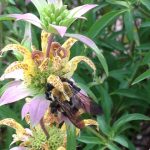
Bee visiting Monarda punctata. Photo: J. McConnell, UF/IFAS
If you are looking for a late summer blooming plant that attracts pollinators and survives in a tough spot, dotted horsemint (Monarda punctata) is for you! This native plant thrives in sunny, well-drained sites but will also tolerate moist garden spots. It grows quickly and blooms prolifically – attracting pollinators by the dozens. A plant covered in blooms is very showy and when you go in for a closer look, you’ll see unique flowers.
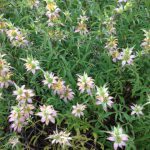
Dotted horsemint brings color to the summer garden. Photo: J. McConnell, UF/IFAS
This plant can get 3 feet tall by 4 feet wide but it is tolerant of pruning in the growing season to keep it tidy and encourage bushiness. Just be sure to prune it before it sets flowers, a good rule of thumb is to prune before the end of June.
Propagation is by division or seed. Few pests affect dotted horsemint.
To read more about this flowering perennial:
Monarda punctata Bee Balm, Horsemint
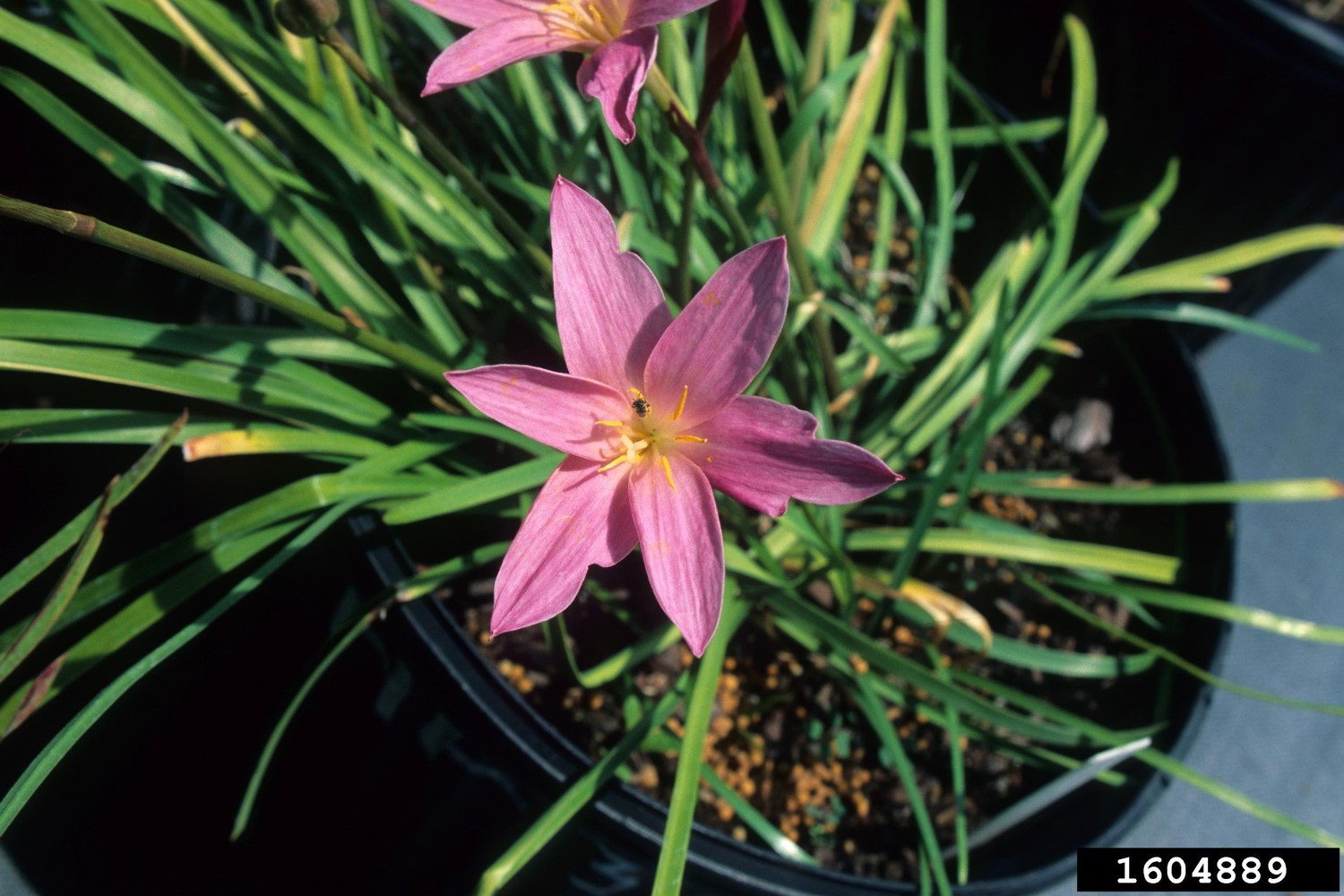
by Mary Salinas | Sep 2, 2016
Florida is home to many gorgeous and desirable native plant species. One to consider for your landscape is the rainlily, Zephyranthes and Habranthus spp. They are easy to care for and are bothered by few pests.
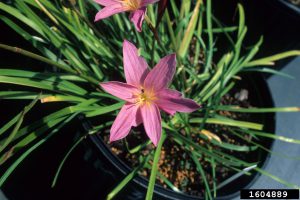
Cuban rainlily, Zephyranthes rosea. Photo: John Ruter, University of Georgia, Bugwood.org
As the name implies, rainlilies do thrive when getting consistent rain or watering. A good soaking rain event will result in blooms within a few days. This love for moisture makes them perfect for rain gardens.
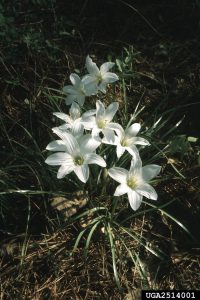
Atamasco rainlily, Zephyranthes atamasco. Photo: Jerry A. Payne, USDA Agricultural Research Service, Bugwood.org.
Plant the bulbs or transplants in full sun to part shade in moist but well-drained fertile soil. Let them be for many years in order to form large impressive clumps and that is when they flower the best. You can also separate the clumps every few years to colonize new areas and pass along to others. After the plants bloom they will reliably set seed that you can collect to start rainlilies in other parts of your garden. However, the seeds are viable for only a short time so you should plant them immediately.
For sources of plant material, try your local nursery that tends to carry native plants or through online sources.
For more information:
Rainlily, Zephyranthes and Habranthus spp.: Low Maintenance Flowering Bulbs for Florida Gardens
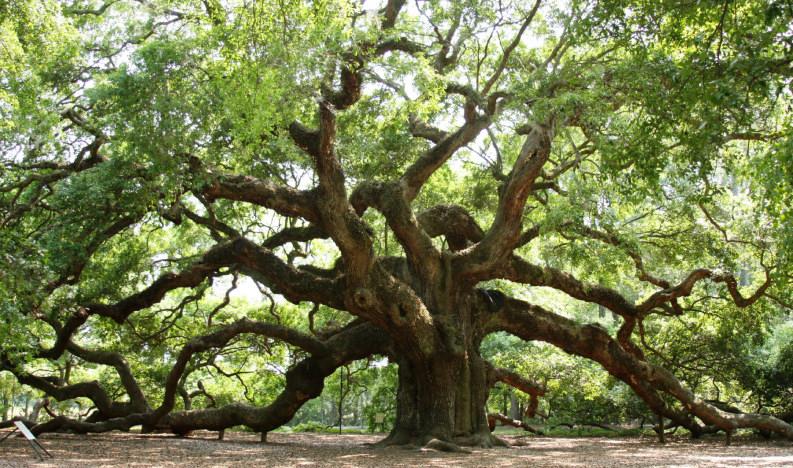
by Daniel J. Leonard | Jul 26, 2016
The Live Oak (Quercus virginiana) is one of the most iconic figures of the Deep South. Mentioning the words Live Oak invokes all sorts of romantic nostalgia of yesteryear and the reputation is not unearned. In fact, many Live Oaks still stand that were growing on American soil when the first English settlers set foot on Plymouth Rock. They are long-lived, picturesque trees that also happen to be nearly bulletproof in the landscape. Given these factors, it is not surprising that Live Oak is far and away the most common tree included in both residential and commercial landscapes in the Coastal South. However, even the venerable Live Oak is not without its problems; this article will discuss a few of the more common issues seen with this grand species.
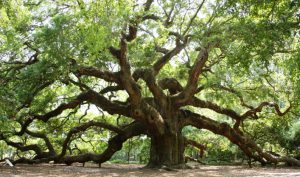
The Angel Oak near Charleston, SC
Few conditions afflict live oak but when they do, improper planting or cultural practices are usually at play. Observing the following best management practices will go a long way toward ensuring the long-term health of a planted Live Oak:
- Remember to always plant trees a little higher than the surrounding soil to prevent water standing around the trunk or soil piling up around it, both of these issues frequently cause rot to occur at the base of the tree.
- If planting a containerized tree, remember to score the rootball to prevent circling roots that will eventually girdle the tree. If planting a B&B (Balled and Burlap) specimen, remember to remove the strapping material from the top of the wire basket, failure to do this can also result in the tree being girdled.
Live Oak has few insect pests but there are some that prove bothersome to homeowners. The following are two of the most common pests of Live Oaks and how to manage them:

Typical galling on Live Oak
Galls are cancerous looking growths that appear on the leaves and twigs of Live Oak from time to time and are caused by gall wasps that visit the tree and lay their eggs inside the leaf or stem of the plant. The larvae hatch and emerge from the galls the following spring to continue the cycle. These galls are rarely more than aesthetically displeasing, however it is good practice to remove and destroy gall infected stems/leaves from younger trees as gall formation may cause some branch dieback or defoliation. Chemical control is rarely needed or practical (due to the very specific time the wasps are outside the tree and active) in a home landscape situation.
- Black Twig Borers can also be problematic. These little insects seldom kill a tree but their damage (reduction of growth and aesthetic harm) can be substantial. Infestations begin in the spring in Northwest Florida, with the female twig borer drilling a pen-head sized hole in a large twig or small branch and then laying her eggs in the ensuing cavity. She then transmits an ambrosia fungus that grows in the egg-cavity, providing food for the borer, other borer adults, and her offspring that take up residence and over-winter in the twig. The activity of the insects in the twig has an effect similar to girdling; the infected twig will rapidly brown and die, making removal and destruction of the infected branches a key component
In conclusion, though there are a few problems that can potentially arise with Live Oak, its premier status and continued widespread use in the landscape is warranted and encouraged. It should be remembered that, relative to most other candidates for shade trees in the landscape, Live Oak is extremely durable, long-lived, and one of most pest and disease free trees available. Happy growing!
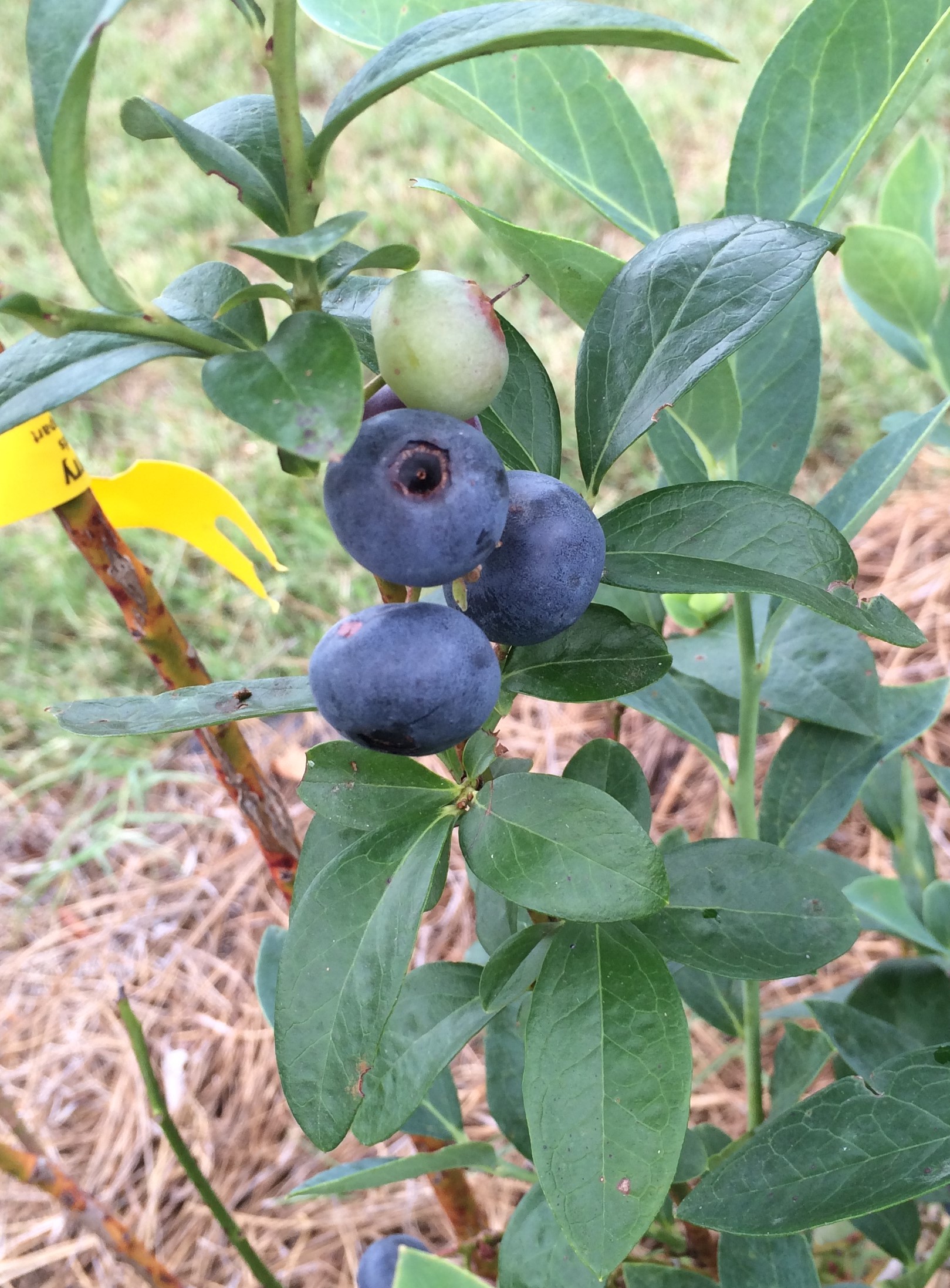
by Molly Jameson | Jun 8, 2016
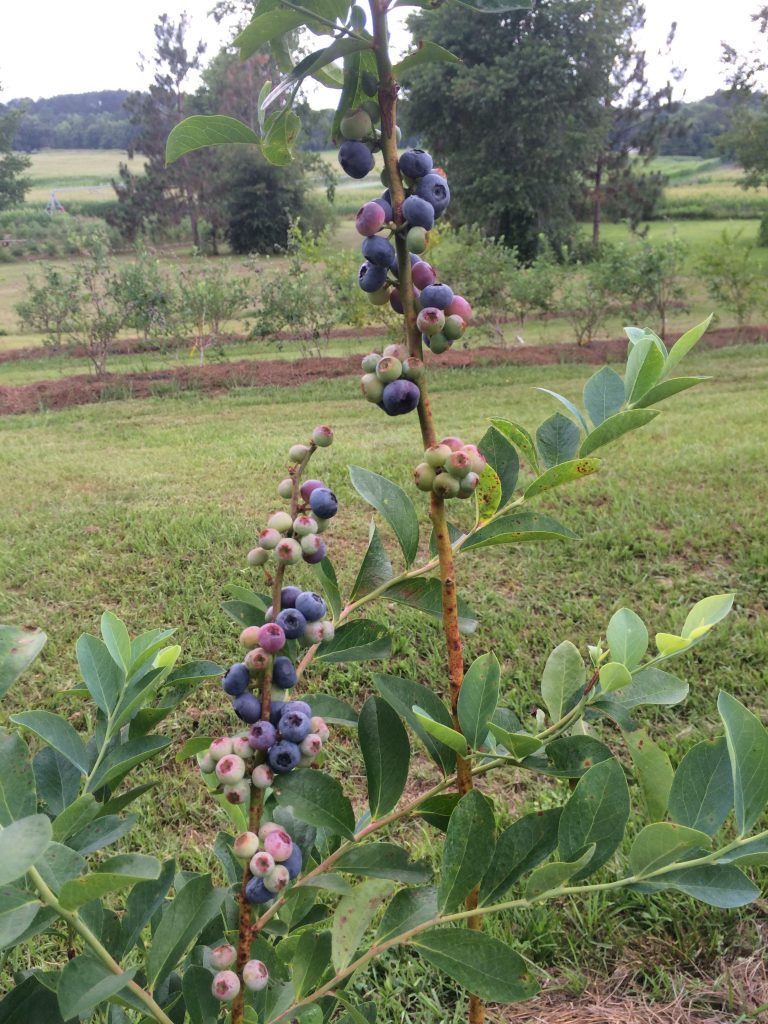
Blueberries beginning to ripen at Blue Sky Berry Farm. Photo by Molly Jameson.
There is something almost magical about picking vibrantly blue blueberries off a bush and eating them fresh. If you watch the blueberries develop, you see them go from shades of pale green and blush red to dark and puffy and bright blue. When a blueberry is ready – you know it!
Blueberries are one of the few crop plants that are actually native to eastern North America. The most popular types are the rabbiteye blueberry (Vaccinium ashei) and the highbush blueberry (Vaccinium corymbosum). Both can be found in northern Florida and southern Georgia, and the highbush blueberry can be found as far north as southeastern Canada. There are at least eight other Vaccinium wild blueberry species that can be found in the woods and near swamps in Florida. They are usually smaller and don’t taste quite as sweet as the rabbiteye and highbush, but birds rely on them heavily for forage.
If you’ve never experienced a fresh blueberry right off the bush, then you may want to consider either foraging for wild blueberries, growing your own, or scouting out a local u-pick blueberry farm near you.
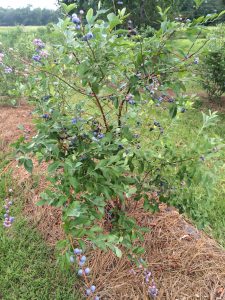
Mulch blueberries with pine straw. Photo by Molly Jameson.
Let’s first consider the joys of growing your own. Blueberries require an acidic soil pH, between about 4.0 and 5.5. Lucky for most of us in the Panhandle, our soil pH is largely naturally acidic. If you have pine trees growing in your area, you most likely can grow blueberries. And the pine straw makes an excellent blueberry mulch! There are many rabbiteye cultivars that have been specifically developed to grow well in our hot climate – requiring fewer “chilling hours” than their northern counterparts. Check out varieties such as Powderblue, Brightwell, Tifblue, and Climax. Highbush blueberries can also do well in northern Florida, although they tend to flower early, making them susceptible to late freezes. Try highbush varieties such as Bluecrisp, Emerald, and Star. Each has its own advantages and drawbacks, such as fruit cracking and insect susceptibility. Click here to learn more about growing blueberries in Florida.
If you are not already growing blueberries, and you want fresh blueberries, then be sure to check out a local u-pick near you. This year you may have noticed we had a warm winter, which delayed the onset of blueberry dormancy. This means the crop is hitting its peak about two or three weeks later than normal. But don’t delay – blueberry season in north Florida typically declines by the beginning of July, so the season is upon us!
If you are in the east Panhandle, be sure to check out u-pick operations such as Blue Sky Berry Farm, Myrtle Creek Farm, Green Meadows Farm, and Blueberry Springs Farm.
Blue Sky Berry Farm, which is located just three miles south of the courthouse in Monticello, on 1180 Ashville Highway, is entering its second season as a u-pick, and its bushes have really grown! They use organic fertilizer and grow using sustainable farming methods. Blue Sky Berry Farm anticipates being open Saturdays and Sundays from 8 a.m. to 1 p.m. this summer, but anyone interested in picking blueberries should first check the Blue Sky Berry Farm website (http://www.bskyfarm.com), as it is updated regularly during the season.
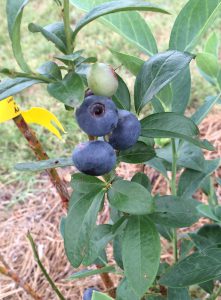
‘Titan’ blueberries at Blue Sky Berry Farm. Photo by Molly Jameson.
Green Meadows Farm, located at 177 East Bluebird Road in Monticello, is five acres of USDA certified organic blueberries. The farm is located among the trees and has been designated a Certified Wildlife Habitat by the National Wildlife Federation. It is open Fridays and Saturdays from 7:30 a.m. to noon and 5:00 p.m. to dusk, and Tuesdays from 7:30 a.m. to noon, while the blueberries last.
Myrtle Creek Farm, located at 2184 Tram Road in Monticello, has beautiful blueberry fields that are dappled with shade in the late afternoon and early evening. They currently have u-pick blueberries and blackberries available. They are open during the weekdays and weekends while the blueberries last, but do call ahead (850-997-0533) to check on availability.
Blueberry Springs Farm is located at 383 Wacissa Springs Road in Monticello, and is celebrating their 25th anniversary of harvesting blueberries. They first planted in December of 1991 and had their first harvest in June of 1991. They are open Tuesdays through Sundays 7:00 a.m. to noon and 5:00 p.m. to 7:00 p.m. You can contact Blueberry Springs Farm at (850) 997-1238 for updates, pricing, and directions.
Also check out the Florida Blueberry Growers Association website and the Florida Department of Agriculture and Consumer Services u-pick locator to discover u-picks around the state, including grape and blackberry u-picks.
Whether you are foraging for wild blueberries, picking your own blueberries, or visiting a u-pick, be sure to bring along plenty of water, a hat, close-toed shoes, and sunscreen, as blueberry season can be a very hot and sunny time of year! But once you’ve experienced your first taste of hand-picked Florida blueberries, you will be hooked and coming back for more each and every summer!
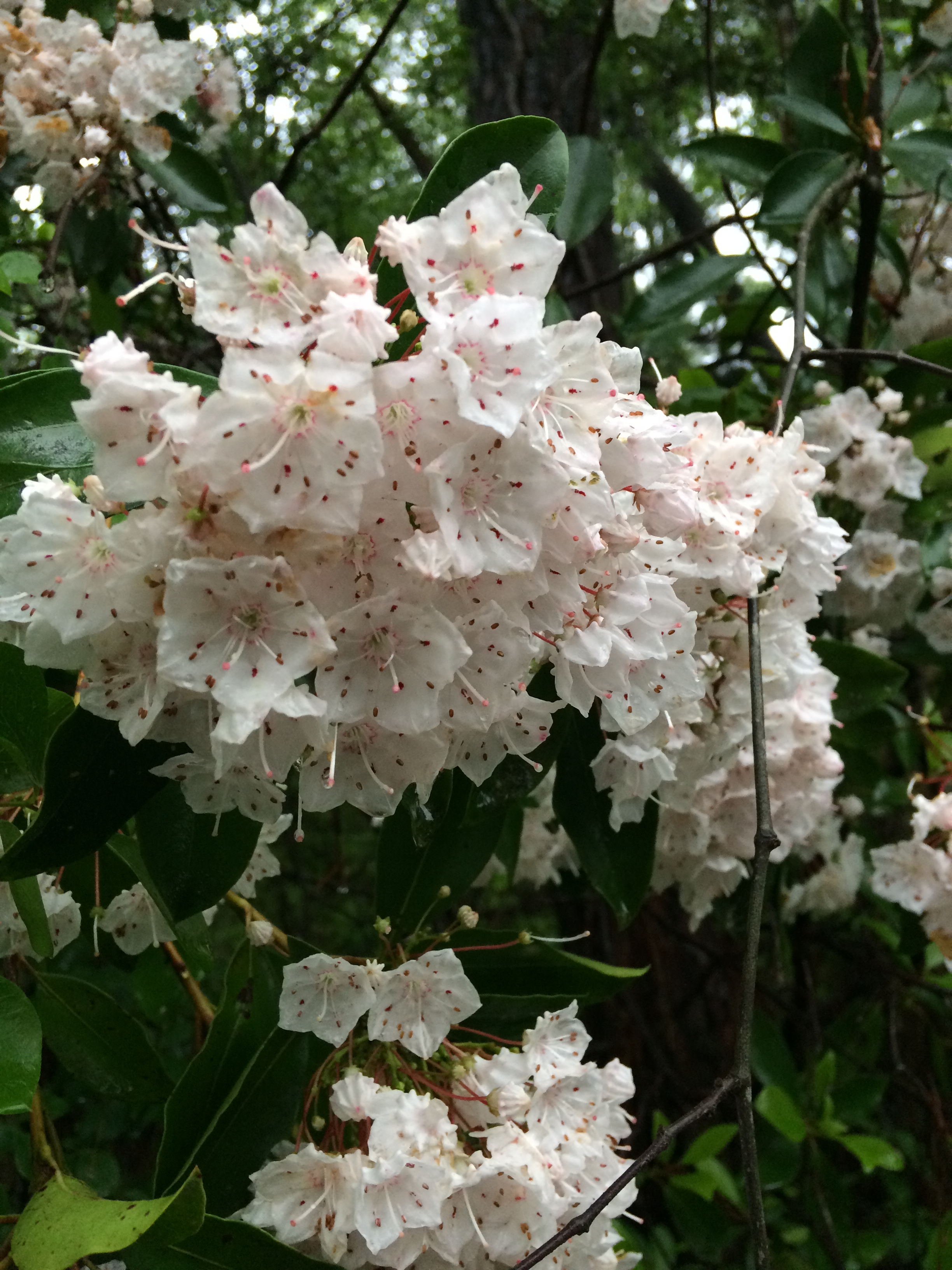
by Sheila Dunning | Apr 21, 2016
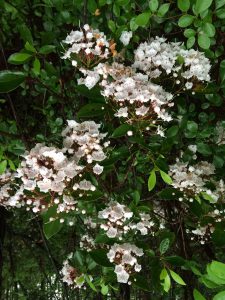
Mountain laurel. Photo credit: Sheila Dunning, UF/IFAS Extension.
If you are lucky enough to live on the southern Alabama edge of northwest Florida, you may want to see if you can find mountain laurel blooming now near the wooded creeks. Its native range stretches from southern Maine south to northern Florida, just dipping into our area. The plant is naturally found on rocky slopes and mountainous forest areas. Both are nearly impossible to find in Florida. However, it thrives in acidic soil, preferring a soil pH of 4.5 to 5.5 and oak-healthy forests. That is something we do have. The challenge is to find a cool slope near spring-fed water.
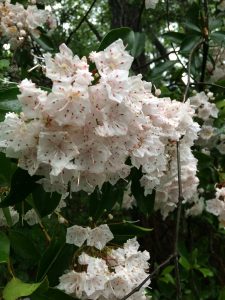
Mountain laurel blooms. Photo credit: Sheila Dunning, UF/IFAS Extension.
Mountain laurel (Kalmia latifolia) was first recorded in America in 1624, but it was named after Pehr Kalm, who had collected and submitted samples to Linnaeus in the 18th century. The wood of mountain laurel was popular for small household items. It is heavy and strong with a close, straight grain. However, as it grow larger it becomes brittle. Native Americans used the leaves as an analgesic. But, all parts of the plant are toxic to horses, goats, cattle, deer, monkeys and humans. In fact, food products made from it, including honey, can produce neurotoxic and gastrointestinal symptoms in people consuming more than a modest amount. Luckily, the honey is usually so bitter that most will avoid eating it.
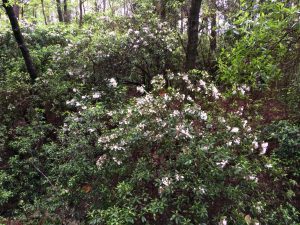
Mountain laurel in its native habitat. Photo credit: Sheila Dunning, UF/IFAS Extension.
One of the most unusual characteristics of mountain laurel is its unique method of dispersing pollen. As the flower grows, the filaments of its stamens are bent, creating tension. When an insect lands on the flower, the tension is released, catapulting the pollen forcefully onto the insect. Scientific experiments on the flower have demonstrated it ability to fling the pollen over 1/2 inch. I guess if you don’t taste that good, you have to find a way to force the bees to take pollen with them.
The mountain laurel in these pictures is from Poverty Creek, a small creek near our office in Crestview. This is their best bloom in 10 years. Maybe you can find some too.
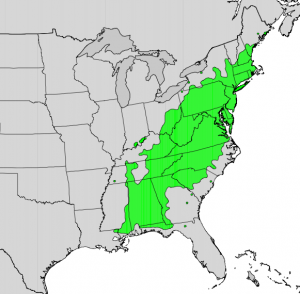
Native range of mountain laurel.
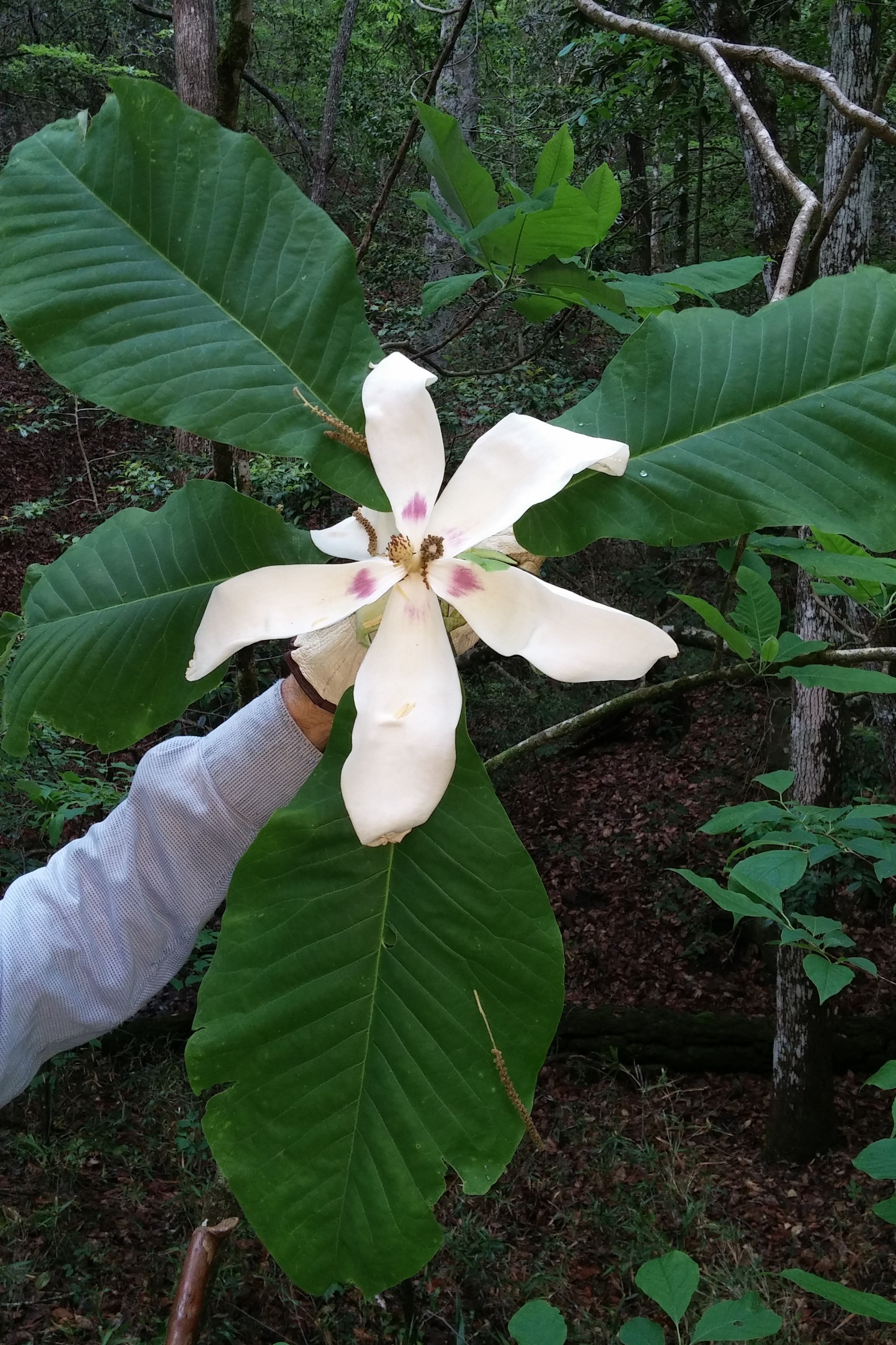
by Gary Knox | Apr 20, 2016
The huge flowers and leaves of Ashe magnolia make it one of my favorite native flowering trees. Individual flowers may be 6 – 12 inches in diameter and are white with purple blotches at the bases of the 3 inner petal-like tepals. When in flower, as they are now in April, the huge white blooms are impossible to miss because of their size and color.
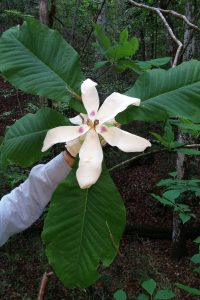
Ashe magnolia. Photo credit: Gary Knox, UF/IFAS.
The leaves are similarly huge, growing 1 – 2 feet long and up to 1 foot across. These large, banana-like leaves offer interest and coarse texture to any landscape.
Ashe magnolia grows as a small tree with a loose, open branching habit up to a height of about 25 feet. The large, light green leaves have whitish undersides and emerge in mid spring prior to flowering. Leaves turn yellowish and fall in autumn, usually without any dramatic color change. Pollinated flowers are followed by reddish, cylindrical, 3-inch fruits producing bright red fleshy seeds in early August.
Native to the Panhandle. This small tree is relatively unknown because of its rarity. Ashe magnolia, Magnolia macrophylla var. ashei, is native in only a few counties in the Florida panhandle and is endangered because of this limited distribution. It is primarily found on the slopes of ravines, growing in the understory of mixed hardwood forest. While it is now illegal to remove this plant or its seeds from the wild, nurseries can grow this plant using seeds from long-cultivated landscape trees.
Garden cultivation. Ashe magnolia makes a lovely small flowering tree if planted in the right location. It grows best in rich, well-drained soil under partial shade, although full sun is tolerated if plants are irrigated during drought. Sheltered sites are best since strong winds can shred the papery leaves and break the brittle branches. You won’t have to wait long for this plant to flower; a unique aspect of Ashe magnolia is that it flowers when young, reportedly when as small as 1 foot tall! Another unusual characteristic is that this Florida native plant is hardy north into USDA plant hardiness zone 6.
Given this species’ beauty, rarity and nativity to the Panhandle, I think it is almost an obligation for panhandle Floridians to cultivate and showcase this plant in our gardens while preserving it in our forests! Seek out specialty nurseries to obtain one of these rare beauties for your garden.
For more information:
Atlas of Florida Plants: Ashe Magnolia
Ashe Magnolia at the United States Botanic Garden
USDA Ashe Magnolia Plant Profile



















